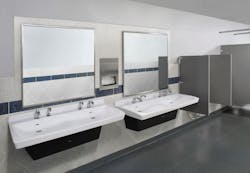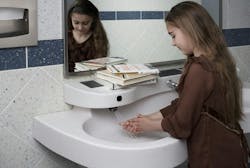Knowledge Center: A hands-on approach
Schools are a place for learning—not only about academic subjects, but also life skills like personal hygiene.
Teaching students about the importance of handwashing—and getting them to do it as part of their bathroom routine—always has been important, but it became an even greater priority when Covid-19 began spreading across the nation and put the health of millions of students at risk.
"Keeping hands clean is one of the most important ways staff and students can stay healthy during the school days," the U.S. Centers for Disease Control and Prevention (CDC) says.
Have students gotten the message? Yes and no, according to the most recent Healthy Handwashing Survey conducted by Bradley Company.
Yes—97% of high school students said they knew that washing hands with soap and water was an important step in maintaining their overall health. Also, no—nearly two-thirds of those teens admit that sometimes they cut corners by skipping the soap and only rinsing with water, and one-third of respondents say they frequently observe fellow students leave the bathroom without any washing or rinsing.
No soap or paper towels are the top reasons students don’t wash hands at school, the survey found.
The survey respondents also were frustrated by how fellow students acted in bathrooms; 57% said they were bothered by reckless student behavior that causes damage to fixtures and equipment, and by used paper towels left in sinks or tossed onto the floor.
The annual survey collected information in January from 1,012 students aged 14 to 18 from across the United States.
Overall, students gave the bathroom facilities in their schools a less than stellar grade; 48% said they would their school’s bathrooms a “C," and 26% gave the bathrooms a “D.”
Most students have been made aware that washing with soap and water is preferable to using hand sanitizer; 72% said they knew that soap and water removes germs more effectively than sanitizer. (The CDC recommends making hand sanitizer available in school areas where soap and water are not readily available.)
A majority of students surveyed said they would like to see the conditions in their school bathrooms improved; 56% said the facilities should be cleaned more often and more effectively, and stocked with soap, toilet paper and other supplies more frequently.
Other common requests from students: Taller stall doors with no gaps between panels to bolster privacy, and more deodorizer or air freshener to combat smells.
Other findings from the survey:
- 70% of students have encountered poor restroom conditions at school. The most common problems: unpleasant odors, too many people in a bathroomn at the same time, clogged or unflushed toilets, and stall doors that don't latch. Because of those poor conditions, most students say they use their school bathrooms sparingly--64% say they limit their visits to once or twice a day. Once a school bathroom is observed to be poorly cleaned or maintained, 57% of students leave without using the facilities, and nearly half avoid that bathroom in the future.
- 74% said they have taken steps to avoid a sick classmate by eliminating physical contact and staying away from them. Some students also said they try to avoid germs in the bathroom by operating toilet flushers with their feet and using paper towels so they don't have direct contact with doorknobs and faucets.
The CDC urges schools to teach students to wash their hands with soap and water for at least 20 seconds and to incorporate hand hygiene lessons in K–12 curricula. It also recommends that schools build time into daily routines for students and staff to wash hands, especially at key times like after bathroom breaks, before lunch, or after playing outside.

